The human body is a means of conducting specific characteristics which must be known by everyone who designs devices which must interface with it and even by people who only work with them, such as doctors, physiotherapists, etc. The human body can be considered an ionic solution, full of devices generating fixed electrical potentials or producing electrical signals with special characteristics. How to deal with these signals requires a great deal of knowledge of how they are generated, how they behave and how we can measure them, capture them for use in external devices or how we can interfere with them by generating external control signals.
Needless to say, a good knowledge of human anatomy and physiology would be very important to complement what we are going to analyze. However, we will try to be very didactic in our explanations, allowing even those who are not professionals in the field to understand.
Positive and Negative Ions
When an ionic compound, for example, sodium chloride (NaCl) decomposes when dissolved in water, chlorine separates from sodium to form positive (Na +) and negative (Cl-) ions. These ions can work as charge carriers, that is, carry electrical currents, and if they are separated by an insulating barrier, for example, they can manifest a tension between them. It is the principle of operation of the batteries.
In the human body we have mainly atoms such as sodium, chlorine, potassium which can easily lose, or gain electrons and when they are in a liquid medium, such as our body, they can function as charge carriers carrying electrical currents or even manifesting tensions between certain points, working as small generators. Consequently, when we analyze the presence of charges and currents in our body, we are faced with two types of charges responsible for two types of electrical or bio-potential potentials which we analyze below. We can say that the human body behaves like a real chemical plant, generating signals which can have different purposes.
The Types of Biopotentials
To understand the potentials, we find in our body, we start with our nervous system. This system is responsible for the exchange of information between the different parts of our body operating with two types of potentials. The cells of our nervous system or neurons use electrical pulses to communicate and thus form a powerful network operating with signals whose complexity goes far beyond simple impulses, as we will see later. In Figure 1, we have the structure of a common nerve cell.
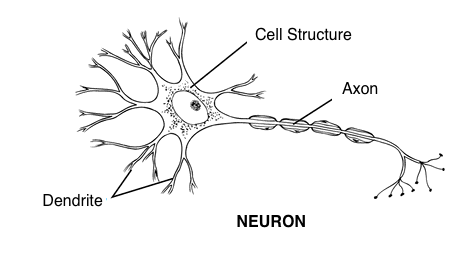
Rod-shaped proteins in the cell membrane form an ion channel. Some of them form a triggering channel while others a resting channel. Opening or closing the channels will depend on the ion which is connected to them. Thus positive ions (sodium) and negative ions (potassium) maintain a balance such that sodium ions are pumped out while potassium ions are pumped in.
In the resting condition, all doors or gates are closed and thus there is a higher concentration of potassium and less sodium inside the cell and the opposite outside. The sodium is then pumped into the cell and the potassium out of the membrane. With this, a balance is maintained generating a constant potential difference, as shown in Figure 2.
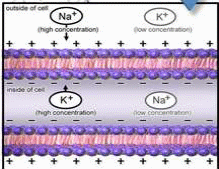
In a second stage, a constant exchange of ions begins to occur along the axon, the sodium ions enter the cell creating a positive internal and negative external polarization. At this point, the sodium port is closed, and the potassium port is opened. The outside is negative, and the inside is positive. Figure 3 shows what happens.
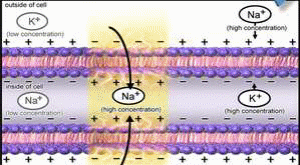
This process propagates along the axon therefore transmitting the information. This is undoubtedly the main electrical signal used in various types of analysis of the human body. In Figure 4, we have a graph showing the intensity of the generated signals.
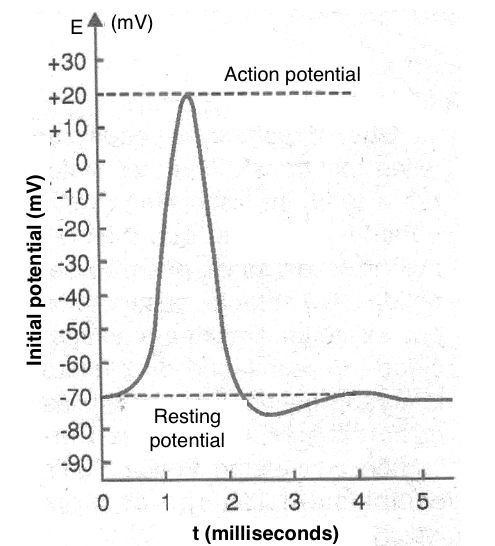
Note that the amplitude of this signal is typically 100 mV, ranging from -70 mV to +30 mV. An interesting point to be observed is that it is an electrical propagation due to chemical exchanges (ions). This slows down the signal, compared to what we expect from electrical communication. While the signal sent by a switch activated to a lamp propagates at the speed of light, the electrical signals in neurons are slow. This explains the reaction time.
Between the instant we touch a hot body. and the information is transmitted to the brain and the time it takes the brain to react and send the command to remove the hand, there is a period of 0.1 second, which is a lot compared to a circuit.
But, even in a circuit, the speed of movement of the loads is much lower in relation to the transmitted signal wave. There is a difference that we have analyzed in other articles in detail.
But going further, when triggered or driven the neuron does not emit a single pulse with these characteristics. The functioning of a neuron is much more complex, and it can be said that it operates with a “PWM” element and not a simple logic gate.
The intertwining of neurons in our brain and at many other points makes the signals complex, which makes the types of interfacing we can elaborate quite difficult.
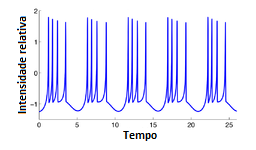
It is interesting to note that neurons adapt to the type of stimulus they receive, and it triggers them by producing signals which change patterns. For example, a very strong signal inhibits them and a very weak one does not trigger them. The range in which the trigger occurs changes with the frequency of the stimuli. For example, many stimuli it inhibits make it start to respond less and less to signals of greater intensity and the response changes. We studied precisely this neuron behavior when we did research at Escola Paulista de Medicina, a Brazilian medicine school, in the 1970s, when we tried to develop an electronic artificial neuron.
By interconnecting neurons with adaptive properties, it would be possible to build a structure capable of learning, such as the Gray Walter Tortoise which we have already discussed in another article and also in the presence of mysterious quantum interactions as recently discovered.
Consequently, much more than connecting electrodes to people to capture signals or pulses externally, its interpretation is extremely complex. We are not yet in a position, for example, to “read a thought” based on the signals captured from the brain. But, even so, some types of signals can be considered consistent for analyzing the behavior of our internal organs and even diagnoses, especially those which depend on the stimulus of neurons, such as the brain, the heart, etc. This leads us to what are called permanent bio-signals as opposed to induced bio-signals.
Two Types of Bio-Signals
Considering what we saw, we can say we found in our body several signals which fall into two broad categories. Permanent bio-signals and induced bio-signals.
Permanent bio signals are those which manifest without any external action. They are inherent to the very functioning of our organism. We can mention the signals generated by the heart, the brain, the muscles...
On the other hand, we have the signals which are induced, generated when an external stimulation occurs. These signals are usually short-lived, but are used in a variety of medical applications. We can use short-term stimuli to check the reaction of muscles, for example.
We can also classify the signals according to their dynamic nature, which also leads us to find two types of signals. We have the signals considered static, which are those that do not change or change very slowly over time, such as blood volume pressure, body temperature and electrical resistance of the skin. Dynamic signals are those that exhibit fast variations in frequency, waveform or intensity.
And, of course, for electronics we have an additional classification which will tell us what type of sensor and circuit we should use for its analysis. This classification considers its origin and nature. We have then:
• Electrical signals: such as those which allow the creation of devices raising the encephalogram (EEG), electrocardiogram (ECG), etc.
• Biomechanical signals: such as the movements generated by breathing which allow the mechanic respirogram to be raised.
• Bio-thermal signals: such as the temperature of the body and specific organs
• Biomagnetic signals: such as those used to analyze muscle activity, called MMG or Mecanomiogram.
• Biomagnetic signals: that are used in the activity of neurons in the brain also known as MMG (magnetomyography). They are based on the fact that electrical activity with the movement of charges in neurons produces magnetic fields that can be detected and analyzed.
• Optical bio-signals: such as those used in photoplethysmography which record changes in volume of the analyzed part of the body or limb occuring due to circulatory phenomena. This technique detects circulatory problems.
• Acoustic bio-signals: for example, on the phonocardiogram in which the functioning of the heart is recorded from the sounds it emits.
• Chemical bio-signals: such as those that occur in the secretion of certain substances. We can mention the sweat that can affect the conductivity of the hair under stress conditions. Figure 6 gives an idea of some signals which can be found in the human body and its use in medicine.

The fact that must be emphasized is that these signals, although until recently they were used only by medicine in diagnosis, nowadays, with the evolution of technology, and with the appearance of many devices interfacing with the human organism, found other important applications. In addition, we have to consider that, just as the organism generates signals, as it is conductive, it is sensitive to external signals. Thus, we can mention the electric shock itself.
External signals can stimulate the nerves causing everything from a simple tingling sensation or even excitement to pain, organ paralysis or death. In the brain, they can induce the most diverse sounds, images and behavior. A use of these signals generated externally or by devices that do not belong to the body is the cardiac pacemaker. Another would be the implantation of chips which correct Parkinson's disease through electrical stimuli in the brain. We also have pain inhibition as in the case of TENS - Transcutaneous Electrical Nerve Stimulation (BM047E).
Non-Medical Applications
But, taking into account the human organism can generate signals as well as receive signals, we can think of a multitude of applications which go beyond simply detecting what is wrong inside us or correcting any problems we may have in the functioning of our organs. With the development of technology and the possibility of having extremely efficient sensors for several types of physical quantities, or chips which can be implanted both receiving internal signals and generating stimulus signals, a multitude of non-medical applications, but which involve the interfacing of our body with the outside world can be imagined.
Bionics is just the tip of the iceberg. We have a goo number of articles exploring its possibilities in our Environment and Health Section (Articles with theAcronym MA) We can take advantage of the signals and sensitivity of the human body to create projects in the areas of:
• Monitoring of physical activity (fitness)
• Food and health
• Conditioning and perception (psychology)
• Stress
• Security and biometrics
• Well-being and interaction with the environment
• Smart home and IoT
Although we have already seen an enormous number of new products on the market, there is still much to be explored.
What the designer needs to know, however, is how to work with these signals, both taking them to the human body and extracting them, and for this some important information must be considered. The human body is a hostile medium for any type of external device and, moreover, if we try to put something inside it there is the problem of rejection.
Interference, noise, galvanic effects and much more can occur requiring the designer to take great care, especially with the way the interfacing is done and also with the possible influence that his equipment may have on the body's own functioning.
Resistance sensors in contact with the skin, for example, can have a galvanic effect. The metal forms with the conductive medium, which represents the skin, forms a medium generating a galvanic potential by circulating between them a current that has an electrolysis effect. The result of this is corrosion of the electrode, the formation of substances harmful to the organism which end up killing the cells on the spot. This is the effect that occurs when a metal is attacked while being buried, a ground bar, for example.
We also remember that the sensors, depending on the type, have characteristics which must be taken into account in their applications, such as inertia (a temperature sensor takes a certain time to balance its temperature with the one of the body it must measure), thermal capacity (a temperature sensor exchanges heat with the body from which it measures the temperature, affecting it), precision and much more which must be taken into account by the designer.
Anyway, working with the human body is not so simple and what we saw in this article is only a part of what the reader should know. In the second part of the article BM078E, we will go on, we analyze in a more complete way some important signals of the human body which can be worked and also some types of stimuli which we can use.




